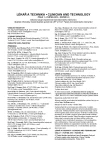Fototoxický vliv porfyrinových sensitizerů a viditelného záření na gram-pozitivní methicilin-rezistentní kmen S. aureus
Authors:
Adéla Hanáková 1; Katerina Bogdanova 2; Katerina Tomankova 1; Klara Pizova 1; Jakub Malohlava 1; Svatopluk Binder 1; Robert Bajgar 1; Katerina Langova 1; Milan Kolar 2; Jiri Mosinger 3; Hana Kolarova 1
Authors‘ workplace:
Ústav lékařské biofyziky, Lékařská fakulta Univerzity Palackého, Institut molekulární a translační medicíny, Olomouc, Česká republika
1; Ústav mikrobiologie, Lékařská fakulta Univerzity Palackého, Olomouc, Česká republika
2; Ústav anorganické chemie, Přírodovědecká fakulta Univerzity Karlovy, Praha, Česká republika
3
Published in:
Lékař a technika - Clinician and Technology No. 1, 2013, 43, 19-23
Category:
Original research
Overview
The use of antimicrobial photodynamic therapy (aPDT) as a therapeutic modality for the treatment of localized microbial infections represents an developing new field. The emergence of strains resistant to antibiotics has provided the necessary impulse for new drug or technology discoveries to combat these resistant compounds. Although the aPDT is still in infancy, its need is still growing. Like PDT, main components of antimicrobial photodynamic therapy are appropriate light, dye called photosensitizer and created reactive oxygen species. In this article photosensitizers TMPyP and ZnTPPS4 are investigated for antimicrobial photodynamic therapy. We tested these porphyrins on bacterial methicilin – resistant strain MRSA alone and bound in complex created with hp-β-cyclodextrin. The light emitting diodes (414 nm) were used at the doses 0 and 150 J/cm2. Tested concentrations were from 0.78 to 100 µM. This experimental work predicated that TMPyP is very successful compound in aPDT. In contrary to ZnTPPS4 which was efficient for eradication of tested gram-positive bacteria only in higher concentrations.
Keywords:
Antimicrobial photodynamic therapy, porphyrins, blue light, light emitting diod
Sources
[1] O’Riordan, K., Akilov, O. E., Hasan, T. The potential for photodynamic therapy in the treatment of localized infections. Photodiagnosis and Photodynamic Therapy, 2005, 2: 247—262.
[2] Chan Y., Lai CH. H. Bactericidal effects of different laser wavelengths on periodontopathic germs in photodynamic therapy. Lasers Med Sci, 2003, 18: 51–55.
Strnadova, A., Roubik, K. Document for the paper for YBERC 2010. Lékař a Technika, 2010, vol. 15, no. 1, p. 1–2.
[3] Hamblin M. R., Hasan T. Photodynamic therapy: A new antimicrobial approach to infectious disease? Photochem Photobiol Sci, 2004, 3:436–450.
[4] Tavares A., Carvalho C. M. B., Faustino M. A., Neves M. G. P. M. S., Tomé J. P. C., Tomé A. C., Cavaleiro J. A. S., Cunha A., Gomes N. C. M., Alves E., Almeida A. Antimicrobial Photodynamic Therapy: Study of Bacterial Recovery Viability and Potential Development of Resistance after Treatment. Mar. Drugs, 2010, 8: 91-105.
[5] Banfi S., Caruso E., Buccafurni L., Battini V., Zazzaron S., Barbieri P., Orlandi V. Journal of Photochemistry and Photobiology B: Biology, 2006, 85: 28–38.
[6] Jori G. Photodynamic therapy of microbial infections: state of the art and perspectives. Journal of environmental Pathology, Toxicology, and Oncology. 2006, 25(1-2): 505-519.
[7] Maclean M., MacGregor S. J., Anderson J. G., Woolsey G. A. The role of oxygen in the visible-light inactivation of Staphylococcus aureus. Journal of Photochemistry and Photobiology B: Biology, 2008, 92: 180–184.
[8] Calin M. A., Parasca S. V. Light sources for photodynamic inactivation of bacteria. Lasers Med Sci, 2009, 24:453–460.
[9] Ganz R. A., Viveiros J., B. Ahmad A., Ahmadi A., Khalil A., Tolkoff M. J., Nishioka N. S., Hamblin M. R. Helicobacter pylori in Patients Can Be Killed by Visible Light. Lasers in Surgery and Medicine, 2005, 36:260–265.
[10] Hamblin M. R., Hasan T. Photodynamic therapy: A new antimicrobial approach to infectious disease? Photochem Photobiol Sci, 2004, 3:436–450.
[11] Banfi S., Caruso E., Buccafurni L., Battini V., Zazzaron S., Barbieri P., Orlandi V. Journal of Photochemistry and Photobiology B: Biology, 2006, 85: 28–38.
[12] Lambrechts S. A. G., Demidova T. N., Aaldersa M. C. G., Hasan T., Hamblin M. R. Photodynamic therapy for Staphylococcus aureus infected burn wounds in mice. Photochem Photobiol Sci., 2005, 4(7): 503–509.
[13] Kudinova N. V., Berezov T. T. Photodynamic Therapy of Cancer: Search For Ideal Photosensitizer, Biochemistry (Moscow) Supplement Series B: Biomedical Chemistry, 2010, 4(1): 95–103.
Labels
BiomedicineArticle was published in
The Clinician and Technology Journal

2013 Issue 1
Most read in this issue
- MOŽNOSTI VYUŽITÍ ANALÝZY PŘEŽÍVÁNÍ V BIOMEDICÍNĚ A TECHNICE
- 13C-methacetinový dechový test u pacientů s jaterní cirhózou a dekompenzovaným srdečním selháním
- Fototoxický vliv porfyrinových sensitizerů a viditelného záření na gram-pozitivní methicilin-rezistentní kmen S. aureus
- SROVNÁNÍ RŮZNÝCH PŘÍSTUPŮ HRANOVÉ DETEKCE KONČETINOVÝCH TEPEN V PODÉLNÉM ŘEZU ULTRAZVUKOVÉHO OBRAZU
